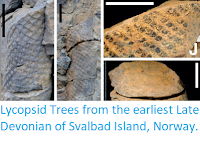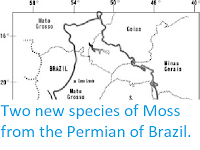The first Vascular Plants appeared some time in the Silurian, but the group did not apparently become a significant part of terrestrial ecosystems until the Early Devonian, when they underwent a major radiation, with a number of new groups appearing. One of these groups was the Rhyniopsids, simple Plants which lacked roots or leaves, but which did have simple stems with some vascular tissue.
In a paper published on the bioRxiv beta database at Cold Spring Harbour Laboratory on 9 October 2017, Kelly Pfeiler and Alexandru Tomescu of the Department of Biological Sciences at Humboldt State University describe a new species of Rhyniopsid Plant from the Early Devonian Battery Point Formation of Quebec.
The new species is named Eddianna gaspiana, where 'Eddianna' honours Dianne Edwards of Cardiff University, for her work on Silurian and Devonian Plants, and 'gaspiana' refers to the Gaspé Peninsula in Quebec, where the Battery Point Formation outcrops and the specimens from which the new species is named were collected. The species is described from eighteen specimens, all preserved as calcareous cellular permineralizations within four cobbles. The stems of the plant are up to 2 mm in diameter, possibly larger, with a central xylem strand that takes up about 80% of the area, surrounded by layer of phloem 1-3 cells thick, then a ridged cortex.
Eddianna gaspiana gen. (A), (B) Axis cross sections exhibiting large primary xylem with potential centrarch maturation cylinders separated from thin, irregular sclerenchymatous cortex by a thin layer of phloem; note incomplete preservation of xylem at centre in (B). (C), (D) same images as in A and B, respectively, colourised to emphasise concentric zonation of the metaxylem, with larger tracheids in the outer zone (yellow) and narrower tracheids in the inner zone (brown); a thin discontinuous layer of very fine tracheids (more conspicuous in (B) and (D)) marks the border between the two zones; note subtle radial patterning of tracheids, locally, in the outer zone, and pattern of decreasing tracheid diameter toward xylem periphery. Scale bars are 300 μm. Pfieler & Tomescu (2017).
The thick cortex of Eddianna gaspiana suggests that these stems were not able to photosynthesise, while the high proportion of xylem suggests that they had a high capacity for water transport, which in turn suggests that these stems are the lower part of a larger plant that has not been preserved, used to convey water up to the photosynthetic part.
Eddianna gaspiana. (A), (B) Longitudinal sections of axis showing (right to left in (A) and left to right in (B)) metaxylem tracheids (light brown) with conspicuous helical wall thickenings; phloem layer (light brown) with narrow cells and fine, straight vertical cell walls; and incompletely preserved sclerenchymatous cortex (dark brown). Scale bars are 50 μm. (C) Longitudinal radial section of axis with large xylem strand (protoxylem compressed, distorted at centre); sclerenchymatous cortex (dark brown, at left and right); and thin phloem sandwiched between xylem and cortex; note conspicuous helical thickenings of metaxylem tracheids and fine band of much narrower tracheids (between arrowheads) between the two concentric zones of the metaxylem. Scale bar is 150 μm. (D) Scanning electron micrograph of tracheids with helical wall thickenings, note spongy structure of the thickenings, characteristic of Sennicaulis-type tracheids. Scale bar is 10 μm. Pfieler & Tomescu (2017).
See also...
Follow Sciency Thought on Facebook.







